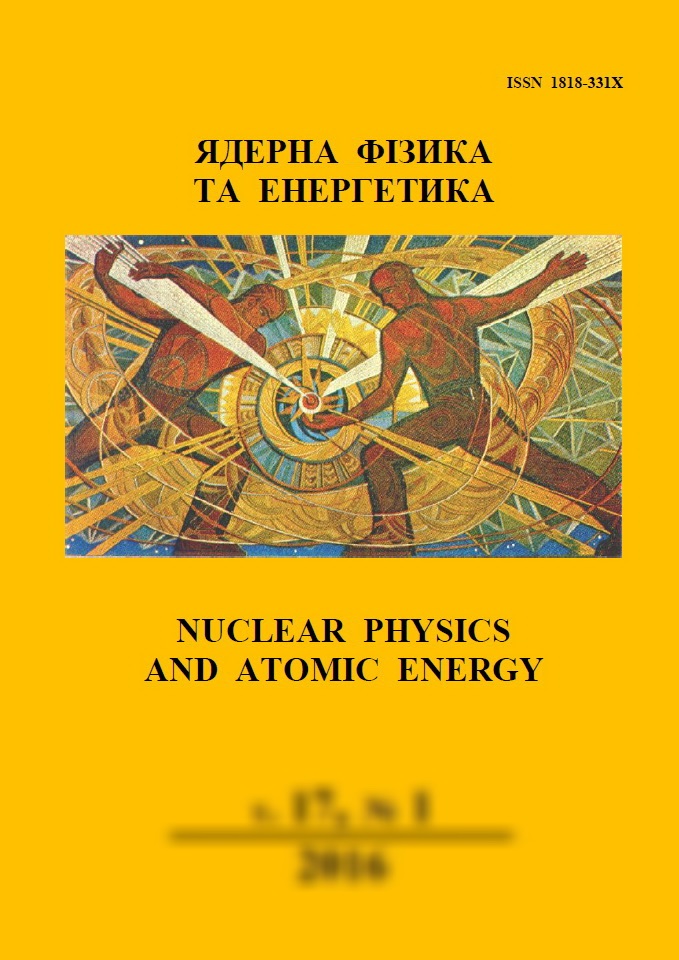 |
ядерна ф≥зика та енергетика
Nuclear Physics and Atomic Energy
ISSN:
1818-331X (Print), 2074-0565 (Online)
Publisher:
Institute for Nuclear Research of the National Academy of Sciences of Ukraine
Languages:
Ukrainian, English
Periodicity:
4 times per year
Open access peer reviewed journal
|
Nucl. Phys. At. Energy 2023, volume 24, issue 1, pages 72-80.
Section: Engineering and Methods of Experiment.
Received: 22.12.2022; Accepted: 16.03.2023; Published online: 12.04.2023.
 Full text (ua)
Full text (ua)
https://doi.org/10.15407/jnpae2023.01.072
Proton beam writing: World experience and prospectives in Ukraine
H. Ye. Polozhii*, A. G. Ponomarev, S. V. Kolinko, V. A. Rebrov, R. O. Shulipa, O. M. Kalinkevich, O. V. Kalinkevich
Institute of Applied Physics, National Academy of Sciences of Ukraine, Sumy, Ukraine
*Corresponding author. E-mail address:
polojiy_ge@ipflab.sumy.ua
Abstract:
Proton beam writing is a promising lithography method that is being developed in many countries. This method has significant advantages over other lithography methods, amongst all, there is the absence of the need for prefabricated pattern masks and a high aspect ratio of fabricated structures. Numerous publications demonstrate prospective applications of proton beam writing in different fields related to micro- and nanostructures fabrication. Proton beam writing may be used both for nanoelectronics and three-dimensional microstructures with a high aspect ratio.
Work on proton beam writing technology is being conducted at the Institute of Applied Physics of the National Academy of Sciences of Ukraine. Last years there were introduced vector proton beam writing method, an electrostatic blanker system for proton beam distortion, and experiments on proton beam writing on chitosan films were conducted, including the films covered with thin films of metals and metal compounds.
Keywords:
lithography, proton beam writing, nanolithography, microlithography, three-dimensional lithography, small-sized structure, chitosan.
References:
1. J.A. Van Kan et al. Micromachining using focused high energy ion beams: Deep Ion Beam Lithography. Nucl. Instr. and Meth. B 148 (1999) 1085.
https://doi.org/10.1016/S0168-583X(98)90667-X
2. J.A. Van Kan, A.A. Bettiol, F. Watt. Hydrogen silsesquioxane a next generation resist for proton beam writing at the 20 nm level. Nucl. Instr. and Meth. B 260 (2007) 396.
https://doi.org/10.1016/j.nimb.2007.02.051
3. F. Watt et al. Proton beam writing. Materials Today 10(6) (2007) 20.
https://doi.org/10.1016/S1369-7021(07)70129-3
4. A.A. Bettiol et al. Three-dimensional metamaterials fabricated using Proton Beam Writing. Nucl. Instr. and Meth. B 306 (2013) 271.
https://doi.org/10.1016/j.nimb.2012.11.050
5. F. Watt et al. Ion beam lithography and nanofabrication: A review. International Journal of Nanoscience 4(3) (2005) 269.
https://doi.org/10.1142/S0219581X05003139
6. X. Xu et al. Design considerations for a compact proton beam writing system aiming for fast sub 10 nm direct write lithography. Nucl. Instr. and Meth. B 404 (2017) 243.
https://doi.org/10.1016/j.nimb.2016.12.031
7. I. Rajta et al. Si micro-turbine by proton beam writing and porous silicon micromachining. Nucl. Instr. and Meth. B 267 (2009) 2292.
https://doi.org/10.1016/j.nimb.2009.03.087
8. V.E. Storizhko et al. The Sumy scanning nuclear microprobe: Design features and first tests. Nucl. Instr. and Meth. B 260 (2007) 49.
https://doi.org/10.1016/j.nimb.2007.01.250
9. D.V. Magilin et al. Performance of the Sumy nuclear microprobe with the integrated probe-forming system. Nucl. Instr. and Meth. B 267 (2009) 2046.
https://doi.org/10.1016/j.nimb.2009.03.015
10. S.V. Kolinko et al. Beam scanning control system for proton-beam writing. East Eur. J. Phys. 3 (2021) 134.
https://doi.org/10.26565/2312-4334-2021-3-20
11. H.E. Polozhii et al. Vector proton beam writing system. Problems of Atomic Science and Technology 3(139) (2022) 52.
https://doi.org/10.46813/2022-139-052
12. M. Caillau et al. Sub-micron lines patterning into silica using water developable chitosan bioresist films for eco-friendly positive tone e-beam and UV lithography. Proc. of SPIE 10587 (2018) 105870S.
https://doi.org/10.1117/12.2292312
13. O.V. Kalinkevich et al. Proton Beam Writing on Chitosan Films for Bionanomedicine and Microfluidics: Pilot Experiments. In: Nanomaterials: Applications & Properties (NAP-2020), IEEE 10th Int. Conf., Sumy, Ukraine, 9 - 13 Nov. 2020 (Sumy, 2020) 02BA03.
https://doi.org/10.1109/NAP51477.2020.9309570
14. O.V. Kalinkevich et al. Controllable structures on the surface of natural polymers made by proton beam writing and femtosecond laser treatment. Low Temperature Physics 48(4) (2022) 393.
https://doi.org/10.1063/10.0009742
